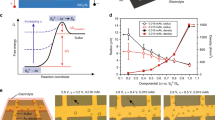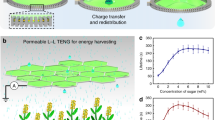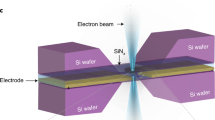Abstract
Droplets of liquid metals attached to an anode in an electrochemical cell move toward the cathode since electrochemical oxidation lowers the interfacial tension of the metal. When the droplet reaches the cathode, it wraps around the cathode but does not touch it despite the electrostatic attraction between the positively charged liquid metal and the negatively charged cathode. The combination of electrochemical oxidation of the liquid-metal anode and hydrogen production on the cathode prevents contact, thus avoiding a short circuit between the two electrodes. Consequently, the liquid metal continues to flow toward the cathode and surrounds it until finally the metal completely detaches from the anode and transfers to the cathode. Such manipulation depends on the distance between the cathode and the liquid metal; only the closest liquid-metal droplet will detach and transfer. During this process, the liquid can adopt surprising shapes that resemble tentacles. We demonstrate and characterize the unique ability to detach and transfer liquid metal using a low applied voltage.
This is a preview of subscription content, access via your institution
Access options
Subscribe to this journal
Receive 12 digital issues and online access to articles
$119.00 per year
only $9.92 per issue
Buy this article
- Purchase on Springer Link
- Instant access to full article PDF
Prices may be subject to local taxes which are calculated during checkout




Similar content being viewed by others
Data availability
All data are available in the main text or the Supplementary Information. Source data are provided with this paper.
References
Creton, C. Pressure-sensitive adhesives: an introductory course. MRS Bull. 28, 434–439 (2003).
Zhao, Y. et al. Magnetic liquid marbles: manipulation of liquid droplets using highly hydrophobic Fe3O4 nanoparticles. Adv. Mater. 22, 707–710 (2010).
Farhan, N. M. & Tafreshi, H. V. Using magnetic field to measure detachment force between a nonmagnetic droplet and fibers. Langmuir 35, 8490–8499 (2019).
Dai, H. et al. Controllable high‐speed electrostatic manipulation of water droplets on a superhydrophobic surface. Adv. Mater. 31, 1905449 (2019).
Roux, J. M., Fouillet, Y. & Achard, J. L. 3D droplet displacement in microfluidic systems by electrostatic actuation. Sens. Actuators A 134, 486–493 (2007).
Serra, P. & Piqué, A. Laser‐induced forward transfer: fundamentals and applications. Adv. Mater. Technol. 4, 1800099 (2019).
Visser, C. W. et al. Toward 3D printing of pure metals by laser‐induced forward transfer. Adv. Mater. 27, 4087–4092 (2015).
Dickey, M. D. Stretchable and soft electronics using liquid metals. Adv. Mater. 29, 1606425 (2017).
Ladd, C., So, J. H., Muth, J. & Dickey, M. D. 3D printing of free standing liquid metal microstructures. Adv. Mater. 25, 5081–5085 (2013).
Wang, Q., Yu, Y., Yang, J. & Liu, J. Fast fabrication of flexible functional circuits based on liquid metal dual‐trans printing. Adv. Mater. 27, 7109–7116 (2015).
Chen, S. et al. Liquid metal composites. Matter 2, 1446–1480 (2020).
Ma, J. Shaping a soft future: patterning liquid metals. Adv. Mater. 35, 2205196 (2022).
Shen, Q. Liquid metal-based soft, hermetic, and wireless-communicable seals for stretchable systems. Science 379, 488–493 (2023).
Johnston, L. et al. Intermetallic wetting enabled high resolution liquid metal patterning for 3D and flexible electronics. J. Mater. Chem. C 10, 921–931 (2022).
Yuan, B. et al. Liquid metal machine triggered violin‐like wire oscillator. Adv. Sci. 3, 1600212 (2016).
Tang, J. et al. Liquid metal phagocytosis: intermetallic wetting induced particle internalization. Adv. Sci. 4, 1700024 (2017).
Idrus-Saidi, S. A. Liquid metal synthesis solvents for metallic crystals. Science 378, 1118–1124 (2022).
Khan, M. R., Eaker, C. B., Bowden, E. F. & Dickey, M. D. Giant and switchable surface activity of liquid metal via surface oxidation. Proc. Natl Acad. Sci. USA 111, 14047–14051 (2014).
Yun, F. F. et al. Voltage-induced penetration effect in liquid metals at room temperature. Natl Sci. Rev. 7, 366–372 (2020).
He, Y. et al. Noncontact rotation, levitation, and acceleration of flowing liquid metal wires. Proc. Natl Acad. Sci. USA 119, e2117535119 (2022).
Yu, Z. et al. Discovery of a voltage-stimulated heartbeat effect in droplets of liquid gallium. Phys. Rev. Lett. 121, 024302 (2018).
Eaker, C. B. & Dickey, M. D. Liquid metal actuation by electrical control of interfacial tension. Appl. Phys. Rev. 3, 031103 (2016).
He, Y., You, J., Dickey, M. D. & Wang, X. Controllable flow and manipulation of liquid metals. Adv. Funct. Mater. https://doi.org/10.1002/adfm.202309614 (2023).
Song, M., Daniels, K. E., Kiani, A., Rashid‐Nadimi, S. & Dickey, M. D. Interfacial tension modulation of liquid metal via electrochemical oxidation. Adv. Intell. Syst. 3, 2100024 (2021).
Hillaire, K. D. et al. Interfacial tension hysteresis of eutectic gallium-indium. Adv. Funct. Mater. https://doi.org/10.1002/adfm.202311501 (2023).
Yu, Z. W., Chen, Y. C., Yun, F. F. & Wang, X. L. Simultaneous fast deformation and solidification in supercooled liquid gallium at room temperature. Adv. Eng. Mater. 19, 1700190 (2017).
Eaker, C. B. et al. Oxidation-mediated fingering in liquid metals. Phys. Rev. Lett. 119, 174502 (2017).
Hou, Y. et al. Coloration of liquid-metal soft robots: from silver-white to iridescent. ACS Appl. Mater. Interfaces 10, 41627–41636 (2018).
Tang, S. Y. et al. Electrochemically induced actuation of liquid metal marbles. Nanoscale 5, 5949–5957 (2013).
Zhang, J., Yao, Y., Sheng, L. & Liu, J. Self‐fueled biomimetic liquid metal mollusk. Adv. Mater. 27, 2648–2655 (2015).
Sheng, L., Zhang, J. & Liu, J. Diverse transformations of liquid metals between different morphologies. Adv. Mater. 26, 6036–6042 (2014).
Mohammed, M., Sundaresan, R. & Dickey, M. D. Self-running liquid metal drops that delaminate metal films at record velocities. ACS Appl. Mater. Interfaces 7, 23163–23171 (2015).
Tan, S. C. et al. Galvanic corrosion couple-induced Marangoni flow of liquid metal. Soft Matter 13, 2309–2314 (2017).
Tang, S. Y. et al. Liquid metal enabled pump. Proc. Natl Acad. Sci. USA 111, 3304–3309 (2014).
Abercrombie, M. Contact inhibition and malignancy. Nature 281, 259–262 (1979).
Adler, J. Chemotaxis in bacteria. Annu. Rev. Biochem. 44, 341–356 (1975).
Acknowledgements
X.W. is grateful for support under the Australian Research Council (ARC) Center of Excellence in Future Low-Energy Electronic Technologies (FLEET) (CE170100039).
Author information
Authors and Affiliations
Contributions
X.W. and Y.H. conceived the project. X.W., M.D.D. and Y.H. designed the experiments. Y.H. and J.Y. carried out the experiments and recorded videos of the results. Y.H., X.W. and M.D.D. conducted the discussion and analysis of the mechanism, and all authors participated in the preparation of the paper.
Corresponding authors
Ethics declarations
Competing interests
The authors declare no competing interests.
Peer review
Peer review information
Nature Chemical Engineering thanks Yukun Ren, Xuechang Zhou and the other, anonymous, reviewer(s) for their contribution to the peer review of this work.
Additional information
Publisher’s note Springer Nature remains neutral with regard to jurisdictional claims in published maps and institutional affiliations.
Supplementary information
Supplementary Information
Legends for Supplementary Videos 1–11; Supplementary Figs. 1–25, Table 1, Discussion and calculation details.
Supplementary Video 1
‘Poking’ the cathode into the anodic LM without short circuiting using a voltage of 5 V.
Supplementary Video 2
Detachment and transfer of one LMD using a voltage of 5 V and a distance of 3.3 cm.
Supplementary Video 3
Short circuit observed for one LMD using a voltage of 2.5 V and a distance of 1.5 cm.
Supplementary Video 4
Selective detachment and transfer of equidistant multi-LMDs using a voltage of 5 V and a distance of 3.3 cm.
Supplementary Video 5
Selective detachment and transfer of non-equidistant multi-LMDs using a voltage of 5 V and a distance of 3.3 cm.
Supplementary Video 6
Continuous transfer process using a transferred LMD as a new cathode with a voltage of 5 V.
Supplementary Video 7
Thick oxide layer preventing the LM from getting close to the cathode with a large gap (~5 mm) under a voltage of 11 V.
Supplementary Video 8
Continuous back-and-forth transfer of one LMD using a voltage of 5 V.
Supplementary Video 9
Controllable transfer position of one LMD between electrodes using a voltage of 5 V.
Supplementary Video 10
Liquid tentacles for grabbing metallic parts using a voltage of 5 V.
Supplementary Video 11
Analogous ‘contact inhibition’ of two LMDs arriving at a cathode at the same time using a voltage of 5 V.
Source data
Source Data Fig. 1
Image source data.
Source Data Fig. 2
Numerical source data.
Source Data Fig. 3
Numerical source data.
Source Data Fig. 4
Image source data.
Rights and permissions
Springer Nature or its licensor (e.g. a society or other partner) holds exclusive rights to this article under a publishing agreement with the author(s) or other rightsholder(s); author self-archiving of the accepted manuscript version of this article is solely governed by the terms of such publishing agreement and applicable law.
About this article
Cite this article
He, Y., You, J., Dickey, M.D. et al. Liquid-metal transfer from an anode to a cathode without short circuiting. Nat Chem Eng 1, 293–300 (2024). https://doi.org/10.1038/s44286-024-00045-1
Received:
Accepted:
Published:
Issue Date:
DOI: https://doi.org/10.1038/s44286-024-00045-1
This article is cited by
-
Directed transfer of liquid metal droplets between electrodes
Nature Chemical Engineering (2024)



